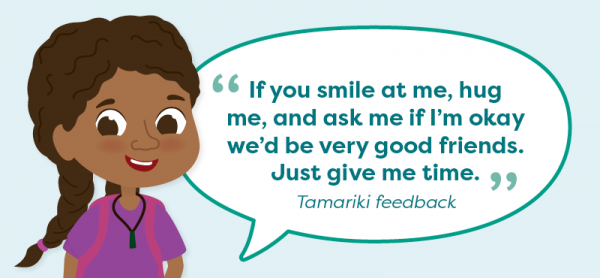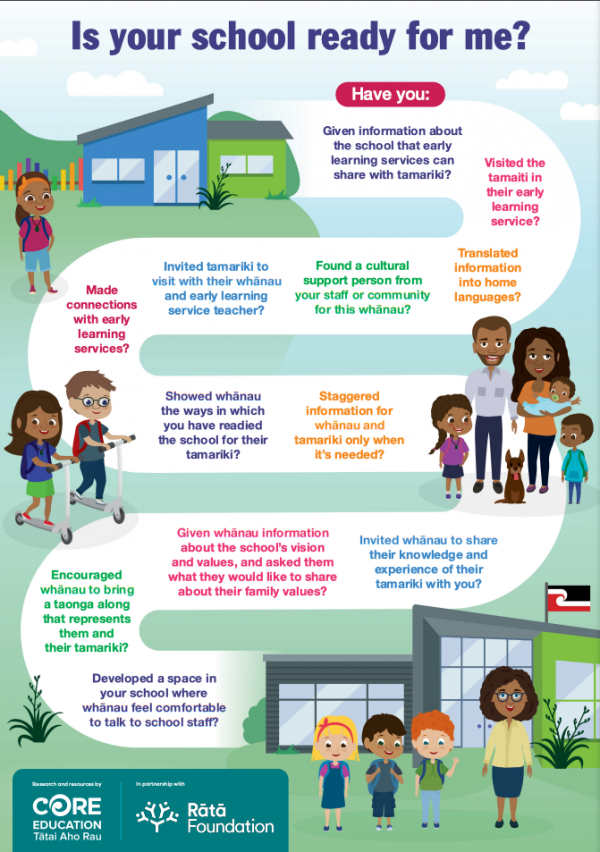English-medium Transition to school
Te hautū i te awa whiria o ako | Supporting pathways to lifelong learning for children in English-medium schools
Support the transition from early childhood education (ECE) to school.
Learning about how to support successful transitions from early childhood education (ECE) to school takes time, attention, and personalised approaches. A successful transition makes a huge difference for a child and their whānau, by giving them a sense of belonging, wellbeing and engagement in their new learning community.
Download the research report (English-medium)
The action research project by Tātai Aho Rau Core Education in partnership with Rātā Foundation set out to make a difference to the transition to school experiences of all tamariki in the Ōtautahi region. The aim was to quickly and sustainably effect change at a systems level. The two-year project reached 68 educators and 4,350 tamariki across six schools in Canterbury.
The research report and resources, Te hautū i te awa whiria o ako | Supporting pathways to lifelong learning for children in English-medium schools, is a result of the research project and provides educators and researchers the opportunity to dive more deeply into the project, findings and recommendations.
-
The why – the whakapapa of the project
In 2017, discussions between Tātai Aho Rau Core Education, Rātā Foundation, and the Ministry of Education around the transition for tamariki from early learning services to schools. Despite a plethora of research, some tamariki continued to experience barriers to learning success. The discussions lead to Rātā Foundation funding Tātai Aho Rau to lead an action research project with six schools and 18 educators in Ōtautahi to explore how to ensure learning pathway for all tamariki, empower agile, innovative, responsive and courageous kaiako and enable systems-level change.
Te hautū i te awa whiria o ako | Supporting pathways to lifelong learning for children in English-medium schools action research report was published in 2021 as a resource on the importance of enabling systems level change within and across learning networks.
Over a period of two years, the research project reached an estimate of 168 educators and 4,350 tamariki, across Canterbury. The report was authored by Dr Sarah Te One, Tracey McAllister and Sarah Whiting.

-
Aspirational outcomes
This project sought to make a difference to the transition to school experience for all tamariki in the Ōtautahi region.
To support tamariki to reach their potential in the new learning environment of school:
- All tamariki will know their identity, language, and culture are valued in their school.
- They will understand that they have a voice and are agents of their own learning.
- They will feel heard and know that their interests and passions will be supported by the learning environment as they continue to develop their learner identity.
To empower educators to be responsive and creative thought leaders:- Educators will have the courage to make changes to their practice through engaging with the action research principles.
- Culturally responsive, agile and innovative ideas will become embedded as pedagogical leadership traits.
To initiate systems that are responsive to learners and whānau as they transition to school:- The system will be transformed to enable changes within, between, and across learning networks.
- Rather than a top-down, linear hierarchical approach, ideally, systems will be focused on learning to learn, learning to do, and learning to be.
Resources developed and shared widely:- The new learning will be mobilised across the sectors through curated spaces, newsletters, meetups, digital stories, and communication hubs.
Ready to start your journey?
This action research project includes the experiences of tamariki, whānau, and educators in the transition to school process.

Take the next step to be tamariki ready with these videos and infographic resources.
-
Successful transitions to school: Listening to tamariki
Research design was led from the ground-up by educators engaged in everyday teaching and learning with and alongside tamariki and whānau. Findings showed that educators can:- collaborate with whānau to ensure tamariki develop a sense of belonging as they transition from early learning services to school
- take small steps to flip the script to become tamariki and whānau-ready, instead of expecting them to be school-ready
- implement meaningful systems level change to ensure tamariki thrive as they begin school and continue their learning journey.
-
Listen to what matters to whānau
Download a transcript for this video
In this video, educators share their ideas about tamariki transitioning from early learning centres to primary school. Together with whānau, they remind us of the importance of working in true partnership to understand the experiences of tamariki during transitions. Educators discuss the value of listening to and checking back with whānau, and the impact this has had on their practice.“It is about building a bridge between home and school. Having home at school, and school at home - extending the village of attachment between home and school.” (Whānau voice) p. 14.
Reflections for kaiako, educators, and teams
After watching this video, think about how you connect with tamariki and their whānau in your learning community, with the following provocations:
- Identify the ways you might invite whānau to share their knowledge and experience of their tamariki with you.
- How might you show whānau how you have readied the learning community for their tamariki?
- As a team, discuss ways you stagger information about your learning community for whānau and tamariki, so that information is only shared when it is needed. Consider how whānau like to receive information in your learning community.
- Reflect on how well this information is translated into home languages. Have you found a cultural support person on your staff or in your community with whānau?
- Work with colleagues to identify a range of actions you can take to build true partnerships with whānau and find out what matters to them.
- In your learning community, create a tool kit (or review your current one) for starting school to support whānau and reduce their anxiety. Ask whānau and tamariki who have been through the transition process to inform the design and content.
-
Listen to tamariki and what matters to them
Download a transcript for this video
In this video, educators at Ilam School share how their observations of tamariki experiencing separation anxiety from their whānau when transitioning to school, sparked them to seek children's perspectives. They collected data from tamariki about what makes them feel happy at school and discovered the importance of play experiences. Listening to tamariki informed key changes to Ilam School by incorporating play approaches and learning stations.“I used to think I listened to children. When they put up their hands, I let them speak. But I decided who. We knew that needed to change.” (Kaiako reflection) p.17.
Reflections for kaiako, educators, and teams
After watching this video, think about how well you consider what matters to tamariki:
- Take a walk through your school and the classroom environment. Consider how it might look and feel for the many different tamariki and whānau in your community. How might they engage with other tamariki and your environment? What will be familiar to them? How will they see, feel, and know that they belong?
- Reflect on how well you listen to the voices of tamariki. How well do you genuinely understand what the experience of starting school means to both tamariki and whānau?
- As a team, explore different ways you might connect with whānau to find out what matters to their tamariki.
- Discuss how these conversations can naturally occur with whānau who speak different languages, and are from different cultural backgrounds. How might you find a cultural support person from your staff or community for this whānau and tamariki?
-
Explore the tuakana-teina approach
Download a transcript for this video
In this video, tamariki and whānau from Kaiapoi North School share their experience of using the tuakana-teina approach. Educators explored how they could ensure that tamariki were building happy connections within their new learning environment. They revamped the school’s buddy system using the concept of tuakana-teina relationship. The tamariki at Kaiapoi North were co-designers of the buddy system with their teachers. They brought valuable insights and ideas on how the system should work.“I felt nervous because I didn’t know anyone. I felt better when someone played with me.” (Tamaiti) p.37.
Reflections for kaiako, educators, and teams
Explore how you can help tamariki develop a sense of belonging:
- Reflect on when, where and how you listen to experiences of tamariki about starting school. Have you asked tamariki to share what makes them feel happy when they come to school? What other ways might there be?
- Who can you learn more from about helping tamariki develop a sense of belonging when they transition to school?
- Reflect on ways you can ask whānau to share what is important to them when their child comes to school.
- How can you support these conversations to happen naturally with whānau who speak different languages and are from different cultural backgrounds? How might you find a cultural support person from your staff or community for this whānau and tamariki?
- How can you strengthen tuakana-teina relationships to support tamariki to develop a sense of belonging and familiarity in your learning community?
-
Understand the power of teacher inquiry
Download a transcript for this video
In this video, educators reflect on their transformative journey of teacher inquiry and action research. They learned how to take time to research, gather observations, and investigate rather than jumping into solving the problem or making assumptions. Learning to be teacher researchers and using different types of data empowered educators to become more agile, innovative, and courageous.
“... we gradually began to understand a different way of working where the ideas and understanding came out of slowing down, taking time, discussing and letting the thinking happen.” (Kaiako) p.20.
Reflections for kaiako, educators, and teams
- As a team, reflect on how well you work together on questions about teaching practice.
- Do you gather data from different sources: tamariki (drawings, conversations and observations); whānau (surveys and focus rōpū conversations); early learning services (conversations and hui)? What strategies might you use? What other ways might there be?
- As a team, how might you share your learnings about supporting successful transitions to school to create shifts in practice and understandings in your learning community?
- As a team, how might you create professional development and learning opportunities between early learning services and schools to collaborate on jointly designed research and professional learning projects?
- As leaders, how might you allocate paid release time for educators to undertake in-depth research and professional learning?
-
“Is your school ready for me?” infographic
Have you thought about what you can do in your learning community to be tamariki ready for when they transition from early childhood education to school? For this research project, educators asked tamariki what makes them happy at school.
Their responses are included in this flipbook for educators to reflect on what matters to tamariki and what changes can be made to support a sense of belonging and connection for every learner.
This resource takes you through the journey of preparing your learning community for new tamariki and their whānau.
Download 'Is your school ready for me?'

Stories of impact
Each teaching team undertook their own inquiry and discovered the impact for their learning communities. Read the case studies:
